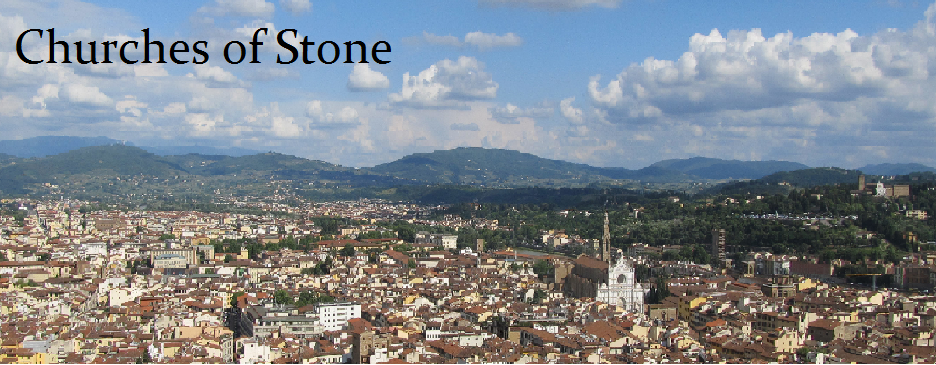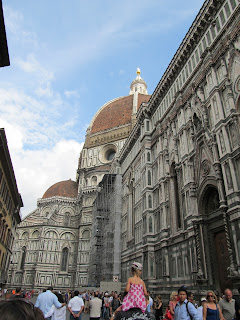You can't even see the tower from the train station (which, by the way, is a wonderful to arrive in Pisa- the train from Florence is superbly short and cheap and totes worth it), and, if you happen to travel on the day after Pentecost, which is also the second Monday of the month, you'll find that many things are closed, such as the visitor's information center. You will, however, find a helpful sign telling you that buying knock-off products is illegal in Italy. Useful.
Christine and I had met a bookshop worker from Canada at the camping ground we were staying at and she had proposed the day trip out to see this city. Kelsey was great to hang out with, from talking to navigating to taking (or attempting to take) pictures of each of us holding up the tower. Together we explored the city. It was quite a worthy day.
We found this map of Pisa on the wall of a cafe
and didn't really take it seriously, though it was the only map we had. We walked down the main street and looked for signs for the tower. On the way, we found a roman bathhouse, called Nero's Palace by the locals, I think.
We turned a corner, trying to figure our way around after being distracted by the bathhouse and I stopped and pointed. There it is, you know, just chilling in the background. The Leaning Tower of Pisa.
There are moments (be prepared for many of them from Rome) that are extraordinarily surreal. The Leaning Tower of Pisa does actually exist. I was there. Along with many other people.And to think that the people who live in this town have always had this in their backyard. They might drive to work in the morning and look in their rearview mirror (if, in fact, Italian drivers use this object in their cars, which often move quickly and with little adherence to traffic laws) and see the tower. It's normal for them. Life is weird.
One piece of advice, if I'm allowed to offer it, is that it is more difficult than you think to get a picture of yourself holding up the Leaning Tower of Pisa. First off, you have to find the best place to do it, and you'll end up standing alongside quite a few other people trying to do the same thing. You have to work out the kinks and the angles and how close you should be to the camera and where the person should standing holding the camera... it's a little bit of a nightmare. A worthy nightmare, in my opinion, but still a nightmare.
 |
| Though it often leads to hilarity. |
You can climb the tower, but we opted for the church.
 |
| Dome not included. |
 The cathedral floorplan is cruciform and there are side aisles with chapels and fancy things and on that long day in Pisa, I was quite honestly over looking at churches. I've seen this all. I mean, there are interesting things about this church, like all others. Like, the big fancy pulpit was actually put into storage after a fire in 1595 because people didn't really like it, but then recovered during renovations in 1926 and put back out. Just to put your life into perspective, construction on the cathedral began in 1093. That pulpit probably sat in the main nave for 400 years before getting put away. Also, there's a lamp beside the pulpit that hung in the exact same place as a lamp that Galileo reportedly saw swinging during mass and thought of the law of the pendulum.
The cathedral floorplan is cruciform and there are side aisles with chapels and fancy things and on that long day in Pisa, I was quite honestly over looking at churches. I've seen this all. I mean, there are interesting things about this church, like all others. Like, the big fancy pulpit was actually put into storage after a fire in 1595 because people didn't really like it, but then recovered during renovations in 1926 and put back out. Just to put your life into perspective, construction on the cathedral began in 1093. That pulpit probably sat in the main nave for 400 years before getting put away. Also, there's a lamp beside the pulpit that hung in the exact same place as a lamp that Galileo reportedly saw swinging during mass and thought of the law of the pendulum.Which shows how interesting the service was.
No, really, it's a nice building but being tired and slightly sick and hungry tends to wear on a person and it kinda knocks the inspiration out of you. So I took pictures for the team (Christine and Kelsey's cameras were both out of battery) and then we went to get lunch.
Then we saw a tower.
And decided to walk to it. It was farther than we thought. I loved walled cities. And, to conclude this stream of consciousness sentence, Galileo!
After we took pictures with the statue of Galileo (really far from the center of town),
we ventured over to a playground and brought out our inner child. Our inner children stuck around and sang Veggie Tales all the way back to the Leaning Tower.
You know, there's this legend that Galileo stood atop the Tower of Pisa and dropped two metal balls of different weights to prove to people that objects fall at the same rate, regardless of mass. It goes against the thoughts of the previous natural philosophers, but that didn't seem to bother Galileo. He also dropped a hammer and a feather to show that air resistance has an effect on objects like the feather, leading us to think that smaller objects fall more slowly. The Apollo astronauts repeated the experiment on the moon, just to prove that, in a vacuum, gravity acts the same on all objects.
I love places that have stories like that. I love that I've been to the Leaning Tower of Pisa, that place that we all pronounced as Pizza when we were kids and were slightly disappointed that there wasn't a huge tower of pizza in Italy. (In Italy's defense, there is wonderful pizza and pasta and budget-breaking wonderful food.) And even though I tramped back to the train station with tired feet, I loved my day in Pisa. After all, I had seen a tower, a church, an astronomer and a playground. What more could a person want in a day?




















































